Harvest of the earliest walnut varieties has begun in some locations. Plan accordingly to obtain the ever-important harvest samples! In a previous post related to almonds, I stressed the value of collecting in-orchard harvest samples rather than relying solely on grade sheets for determining end-of-season damage. While grade sheets are the basis for payment and rejects, they often do not tell the whole story. An in-field collection and crack-out of nuts can provide a lot of additional information to guide future integrated pest management (IPM) decisions. Examining harvest samples to identify the sources of damage (insect and otherwise) is a vital practice to help evaluate your overall pest and crop management programs. Block-specific historical records are an invaluable resource that allow you to reflect on the efficacy of this season’s management activities and plan for the future.
In walnuts, harvest samples can reveal a number of common sources of kernel, shell, and hull damage. These include damage caused by insect pests, diseases, and environmental/physiological factors. Knowing the culprit provides valuable information, such as: How successful was my pest management program this season? How effective were my treatment decisions, timings, materials, and applications? What might I need to do differently next year? Information from annual harvest samples should be kept to establish block-specific historical records, which help focus pest management activities in subsequent years. With worm damage, noting the size and stage of development (larvae, pupae, emerged pupae) indicates when the initial infestation occurred and can be compared with monitoring and treatment records to improve future pest management decisions.
Ideally, UC IPM guidelines recommend collecting a sample of 1,000 nuts per block in walnuts. However, you know your orchards best. Obtain a representative sample of nuts from each block at harvest. In walnut orchards with two shakes, obtain a proportional sample at each shake. Collect nuts from multiple areas of the block. If you are collecting after nuts have been blown into rows, make sure to collect a stratified sample from the pile (not just nuts sitting on the top layer – infested nuts may weigh less and be a larger proportion of those on the top layer). Larger blocks may require more samples to provide an accurate estimate of damage identification. However, smaller blocks with a great deal of variation in pest pressure may require more samples than larger, more uniform blocks. Multiple years of sampling and site-specific historical records can help guide your harvest sampling process.
In a perfect world, samples should be processed soon after collecting. However, storing harvest samples and cracking out once things slow down is often necessary. At a minimum prior to storing for any length of time, refrigerate the samples, remove hulls within a few days of collection, and record any hull infestation or damage. This will limit rotting and movement of pests between nuts. Once hulls are off, relatively dry nuts will hold for a period of time in cold storage (refrigerator temperatures); however, freezer temperatures are best for longer term storage or when seeking to identify pest developmental stage.
The information, table, and photos that follow provide information that can help identify the sources of damage in your walnut harvest samples.
Insect damage typically encountered in walnut harvest samples include navel orangeworm (NOW), codling moth (CM), and walnut husk fly (WHF). Descriptions and photos of each pest are below. In addition, damage caused by environmental and physiological problems (e.g., sunburn, oilless nuts, water or nutrient stresses) and disease (e.g., blighted nuts caused by bacterial blight or the Botryosphaeria/Phomopsis fungal complex) may be evident in harvest samples.
- NOW: Larvae milky white to pinkish with brown head capsule. Look for the dark crescent shapes on second segment behind the head capsule on either side.
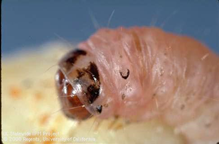
Navel orangeworm (NOW) larva showing characteristic crescent-shaped marking.
- CM: Similar in appearance to NOW, but lacking crescent shaped markings.
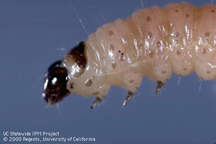
Codling moth (CM) larva.
- WHF: Small, legless maggots. Early instars are whitish; older instars yellow. Other maggots you may encounter in the hulls of already damaged, dropped, or blackened nuts belong to a different group of flies (vinegar flies). These are secondary invaders of nuts already damaged by other causes and do not require in-season treatment. Try to distinguish vinegar fly infestation from WHF damage at harvest. Vinegar flies are narrower in shape and remain white throughout development.

Walnut husk fly (WHF) maggot.
The table and photos below summarize key characteristics of some of the damage you may encounter in walnut harvest samples.
| Kernel | Shell | Hull | Frass | Webbing | Boring | Feeding Behavior | |
|---|---|---|---|---|---|---|---|
| Codling Moth | Deep chewing into kernel | Entries may be visible | Entries may be visible | Frass at point of entry and in distinct feeding tunnel | Very little | Into husk and kernel | Single larva feeds per kernel |
| Navel Orangeworm | Deep chewing into kernel | Entries may be visible; Shells of heavily infested nuts appear oily | None | Often quite a lot throughout kernel | Often quite a lot throughout kernel | Into kernel | Larvae feed in groups; Can be many per kernel |
| Walnut Husk Fly | Shriveled, darkened kernels (early-season infestation); Little kernel damage (late-season infestation) | Shells stained black | Hulls blackened; Cannot be removed cleanly from shell | No | No | Into husk | Larvae feed in groups; Many per husk |
| Sunburn | One side of kernel darkened and shriveled | One side of shell darkened | One side of hull darkened and shriveled; can be removed cleanly from shell | NA | NA | NA | NA |
| Type of Damage | Photo | Additional comments |
| Codling moth | 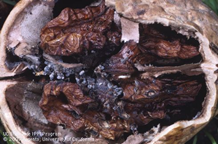 | Infestation does not necessarily result in a darkened kernel at harvest as shown. |
| Codling moth |  | Early season infestation. |
| Navel orangeworm |  | |
| Navel orangeworm |  | |
| Walnut husk fly | 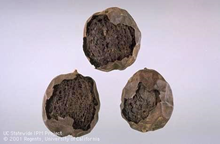 | Walnut husk fly damage to the walnut hull. |
| Sunburn | 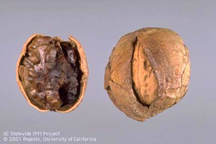 | |
| Botryosphaeria |  | Hulls of Bot-infected nuts will initially turn black and soft, but by late summer to early fall will dry to a black/brown color. Photo: T. Michailides |


Leave a Reply